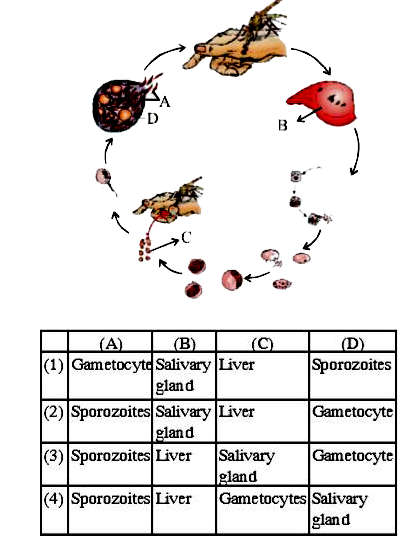The deteriorative processes in plants that naturally terminate their functional life are collectively called
(a) Wilting
(b) Abscission
(c) Plasmolysis
(d) Senescence
Wilting
Abscission
Plasmolysis
Senescence
The correct Answer is:D
To solve the question regarding the term that describes the deteriorative processes in plants that naturally terminate their functional life, we can follow these steps:
1. Understand the Question: The question asks for a term that collectively describes the processes leading to the end of a plant's functional life.
2. Analyze the Options:
- Option (a) Wilting: This refers to the loss of turgor pressure in plant cells, leading to drooping. It is a symptom of water loss but does not encompass the entire process of plant death.
- Option (b) Abscission: This is the process of shedding leaves, flowers, or fruits. While it is a part of the life cycle of a plant, it does not refer to the overall deterioration or death of the plant.
- Option (c) Plasmolysis: This is the process where plant cells lose water in a hypertonic solution, leading to cell shrinkage. It is a cellular phenomenon but not a term for the overall deterioration of the plant.
- Option (d) Senescence: This is the process of aging in plants, which includes the gradual deterioration of function and ultimately leads to death. It is a controlled process that conserves nutrients before the plant parts are shed.
3. Select the Correct Answer: Based on the analysis, the correct answer is (d) Senescence. This term encompasses the overall processes that lead to the natural termination of a plant's functional life.
Final Answer:
The correct option is (d) Senescence.
---
- Option (a) Wilting: This refers to the loss of turgor pressure in plant cells, leading to drooping. It is a symptom of water loss but does not encompass the entire process of plant death.
- Option (b) Abscission: This is the process of shedding leaves, flowers, or fruits. While it is a part of the life cycle of a plant, it does not refer to the overall deterioration or death of the plant.
- Option (c) Plasmolysis: This is the process where plant cells lose water in a hypertonic solution, leading to cell shrinkage. It is a cellular phenomenon but not a term for the overall deterioration of the plant.
- Option (d) Senescence: This is the process of aging in plants, which includes the gradual deterioration of function and ultimately leads to death. It is a controlled process that conserves nutrients before the plant parts are shed.
The correct option is (d) Senescence.
Topper's Solved these Questions
- PLANT GROWTH AND DEVELOPMENT BOOK - CENGAGE BIOLOGY ENGLISHCHAPTER - PLANT GROWTH AND DEVELOPMENT EXERCISE - Assertion-Reasoning
5 Videos
- PLANT GROWTH AND DEVELOPMENT BOOK - CENGAGE BIOLOGY ENGLISHCHAPTER - PLANT GROWTH AND DEVELOPMENT EXERCISE - Archives
28 Videos
- PHOTOSYNTHESIS IN HIGHER PLANTSBOOK - CENGAGE BIOLOGY ENGLISHCHAPTER - PHOTOSYNTHESIS IN HIGHER PLANTSEXERCISE - ARCHIVES
30 Videos
- PLANT KINGDOMBOOK - CENGAGE BIOLOGY ENGLISHCHAPTER - PLANT KINGDOMEXERCISE - ARCHIVES
70 Videos
Similar Questions
The study related to the structure and function of cell is called as
(a) Physiology
(b) Cell biology
(c) Histology
(d) Cytology
View SolutionThe plants growing in dark ,show yellowing of leaves and elongated internodes, this condition is called as
(a) Etiolation
(b) Chlorosis
(c) Dechlorosis
(d) Dark effect
View Solution
Knowledge Check
Water evaporation from plant parts is called :
(a) translocation
(b) transpiration
(c) guttation
(d) tensionAtranslocationBtranspirationCguttationDtensionSystematic enumeration of plant species occurring in a given region is called :
(a) flora
(b) fauna
(c) monograph
(d) manualAfloraBfaunaCmonographDmanual
A plant cell without cell wall is called
(a) Etioplast
(b) Aleuroplast
(c) Amyloplast
(d) Protoplast
View SolutionThe smallest functional unit of kidney is
(a) Nephron
(b) Collecting tubule
(c) Glomerulus
(d) Bowman's capsule
View SolutionThe decimal expension of 147120 will terminate after how many places of decimal? 1 (b) 2 (c) 3 (d) will not terminate
View SolutionIdentify the likely A, B, C, D in the following life cycle : -

View SolutionA plant proteinase is
(a) papain
(b) Trypsin
(c) Pepsin
(d) Urease
View SolutionCohesion force existing amongst water molecules contributes to
(a) plasmolysis
(b) Ascent of sap
(c) Osmosis
(d) Translocation
View Solution
